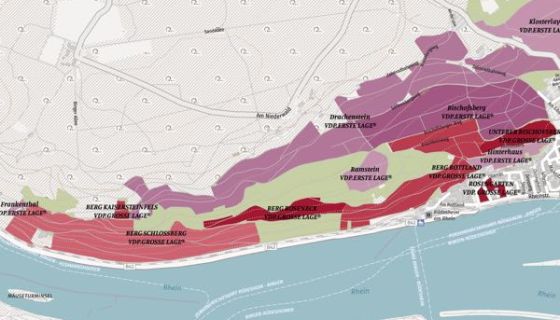22 January 2018 Today, after three years of rigorous research and careful cartography, the VDP’s magnificent new online map site goes live.
In Jancis’s perfectly concise phrase, wine is ‘liquid geography’, and in all the time I have been enjoying and learning about wine – learning about it in order to enjoy it even more – the one source of information that pleases me most is the map because it can tell us so much about why a wine tastes as it does.
However, this new VDP website is more than just a collection of interactive maps. It puts every one of 771 demarcated vineyards into context, from region to village to specific parcel of land, and it provides detailed information on the steepness, elevation, aspect, soil and climate that pertain to that specific site. Although it takes a few minutes to find your way around, the maps are zoomable down to immense detail (eg street names, producer locations). Using a trackpad and a Mac, I found the zooming was very fast and I had to learn to be a bit more gentle but you can also zoom in and out using the usual plus and minus signs.
In addition, you can find out which VDP winemakers farm those sites, the history of the vineyard, illustrated by photos as well as maps. The screenshots below give you an idea of the level of detail for one vineyard, in this case the Rheingau's Berg Schlossberg, but these static images don't really give you the feel of how the site flows – to see that you'll need to try it out by going to VDP.Vineyard.Online and playing around with it.






While this resource is restricted to vineyards farmed by VDP members, linking to the existing VDP site for member profiles, for example, it effectively includes all the most important vineyards. As managing director of the association Hilke Nagel points out, ‘Generally speaking, one precondition for VDP membership is to work on the best and very best sites in Germany. Thus VDP members naturally own a big portion of them. When we started the classification, of course we first looked at the sites in VDP hands. Regarding the demarcation of the precise borders for each classified site (Erste or Grosse Lage) in the maps, the proposition for all regions was to classify all parcels of a site that are great – without respect of ownership of the parcels and of course including the non-debatable great sites.’
Although it is, according to the VDP, ‘the most extensive online vineyard compendium in the world’, they also also admit that ‘this is and will always be work in progress. We have new members coming, we have members renting or buying new land and of course we enlarge also permanently our horizon in respect to knowledge etc. We are aware of imperfection, but we have always dared to break new grounds, get into discussion with the public and also make corrections. It will not be different this time.’
Students of German wine law will know that in 1971 a classification was established based on the ripeness of grapes, ie the level of sugar in the berries at harvest, using terms such as Kabinett, Spätlese, Auslese, etc. Such a system has become more and more anachronistic, particularly with the increasing trend towards dry wines and a focus on exact place of origin, in food as well as wine. Spätlese trocken is hardly a help to anyone new to German wine labels who might once have been told that a Spätlese is a sweetish wine but that trocken means ‘dry’.
This mammoth resource for German wine lovers, which has kept 10 people busy for the last three years, encompasses:
- 771 vineyards (428 Grosse Lagen, 324 Erste Lagen and 19 vineyards for Ortswein (village-level wine)
- 2,800 photos
- data from 195 winemakers.
When it's complete, there will be texts about each one of the Grosse Lagen and everything will be translated into English – most of it already is. Eventually all this information will be integrated into the VDP mobile app. Another well-considered feature is the print function: the material is divided in such a way as to make printing of a page quite straightforward, with the page breaks in the right places and a print button on every page.
Remarkably, this treasure trove is free, unlike Burgundy’s ClimaVinea app based on the classic Pitiot maps, which is excellent – and has been very useful to me during burgundy week – but costs £23.99 (around $33).
Well done team VDP!













